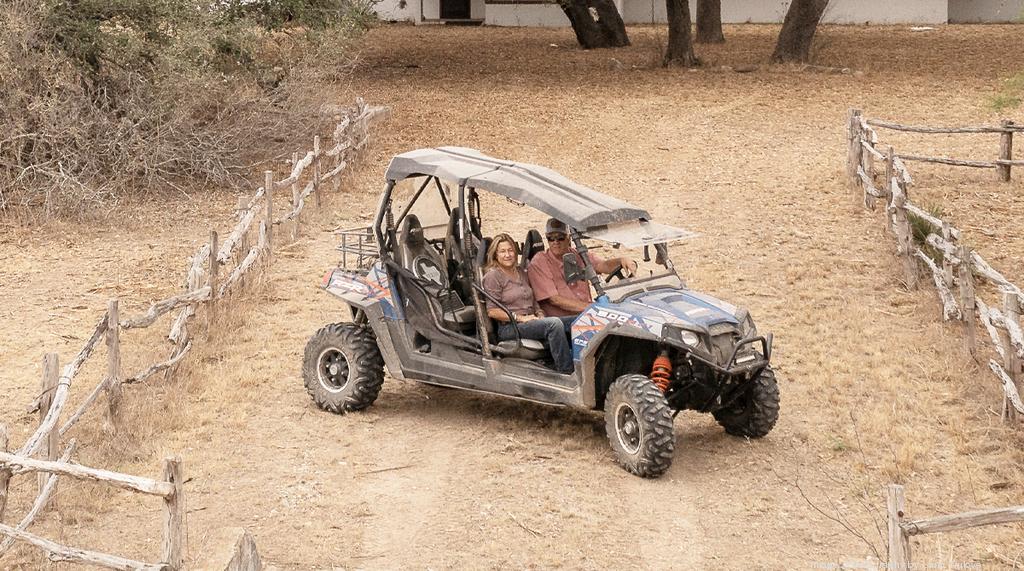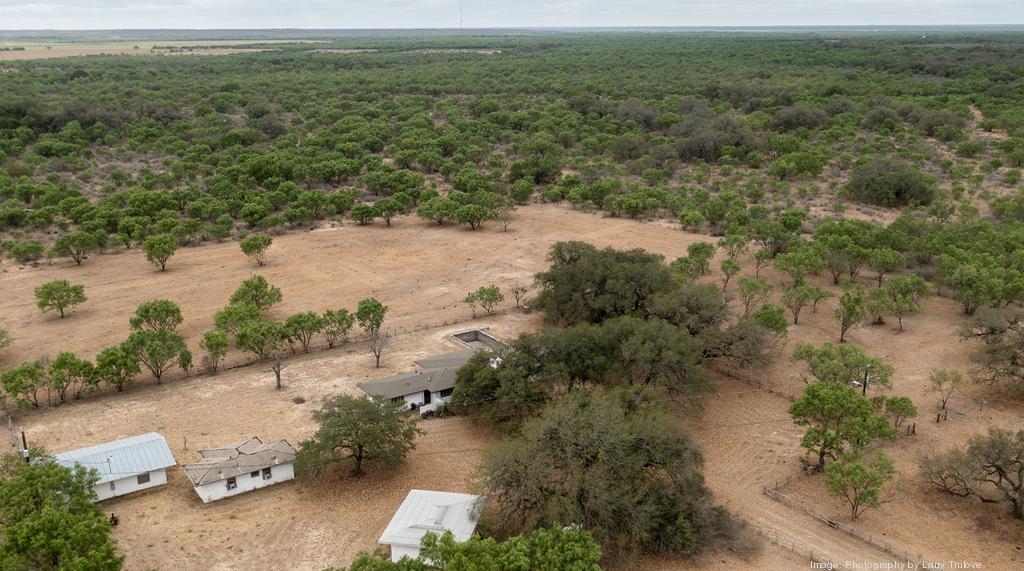
Fred Winston and his wife Shelly watch the sunset’s dynamic display of the evening’s amber light fading from orange to dusk from the backyard of their house on the Winston Ranch eight miles south of Sabinal. Once on the ranch, where the Sabinal River divides east and west, the couple rarely leaves their 6500-acre sanctuary. Instead, they prefer to drink in the wonder of watching the stars beginning to appear in the south Texas night sky. The couple has a daily ritual of riding their UTV through the pastures and up onto a remote guajillo ridge where various flint stones, fossils and other treasures slumber waiting for Shelly, an avid rock hunter, to discover them. “It’s like they wait for the time when they are ready for you to discover them,” Shelly says while she laughs at herself. “I’ve never met a rock I didn’t like.”
The Winston ranch originally owned by Fred’s grandfather, James Overton Winston, was 10,000 acres when purchased in the 40’s, but through the years some relatives sold their inherited property. Fred and Shelly held onto their land and bought contiguous parcels that enable them to access their acreage from highway 187. The older entrance was off a country road and required crossing through other ranches and opening and closing multiple gates.
Arrowheads, gaming balls, knives, shark teeth, bits of iron ore and skinning tools are displayed on the front porch of the small wooden house that the couple added to the ranch in 1992 soon after they were married. “The Shane sisters had owned it and lived here before us.” Shelly shares, “They left most of their furniture and kitchen appliances. It’s like a time capsule of the late 40’s to mid-50’s.” The couple appreciates the history and choose to preserve it as it is. They live in their Montrose, Colorado home during the hot summer months in Texas and return to the Winston when the snow begins to fall and the temperatures drop in Colorado.
“This is my Texas Branch. This is all I need.” Fred says as he points to his desk and computer nestled by the dining room window where the investment advisor conducts his workdays from November through early May. Their son, J.T. Winston, loves the ranch and visits as often as he can. A member of the rowing crew for the Division I Broncos at Santa Clara University in California, J. T. shares his parent’s love for anything outdoors and hunting. The physical challenges of fixing fence and running large equipment give him a welcome chance to clear his thoughts and sometimes refocus his direction. “It’s my favorite place on earth, honestly,” J.T. shares. “It was such an integral part of my childhood. Riding around with my dad, checking the fences, watching the seasonal changes, and following the wildlife throughout the years has taught me how to respect the land. We want to preserve it and honor it.” J.T. fondly recalls every holiday season at the main house full of his cousins and friends from the city when they have traditionally been invited down for new year’s at the ranch. The young chemistry major looks forward to being able to spend more time there when he graduates from college and settles into the workforce in Texas.
Living a semi-nomadic lifestyle and having to adapt to environmental changes has been a part of Fred’s life since he was a youth. When he was only 16 years old, he suffered a life-altering truck accident in Colorado while attending Fountain Valley High School. The accident left him paralyzed from the waist down, ending his participation in his beloved high school team-roping sport. He didn’t, however, let the accident stop him from fully engaging in what he loved. With his supportive parents, grandparents and his brother, he overcame the many challenges he was faced with, allowing him to reclaim his independence. Despite his mobility challenges, his passion for hunting continues, as does his love for the tranquil and simple life close to nature.

The amazing food for that weekend is part of the Winston family’s legend. A place setting of presidential china gifted to the hosts sits in a place of honor on the dining porch where a mesquite table and chairs hand-crafted by Sabinal’s own, Gary Hart, also sits in its place of honor awaiting the next dinner party. “Phenomenal that the cooks made all of the meals in this small kitchen on this simple stove with only six burners,” Shelly remarks, “but they did a wonderful job. No one ever complained about any of the meals that came through these swinging doors.”
In addition to the Shane property, in 2007 Fred and Shelly purchased another property contiguous to their ranch, the historic 1853 Patterson settlement. A historical marker presented by the State Historical Survey Committee tells of the original rock structures which have some of the same architectural features as many of the historic 1850’s rock homes in central Texas. The plaque reads, “Old Patterson Home, 1853. Slave-Built. Owned since 1872 by the Shanes. Pre- Civil war kitchen is now guest house.” The main house features a screened in gallery porch facing east, and its back wall fronts the Sabinal River, a fact that caused some massive damage in 2007 when the Seco Creek, the Ranchero Creek and the Sabinal River all flooded. “As dry as it is, it’s hard to imagine there was so much water in this building,” Shelly remarks as she points to the water line three feet above the floorboards. During this flood, the Winstons and their neighbors had an impromptu party on the island that had become their ranches. Four families converged to trade stories and comments about their flood experiences. A helicopter pilot saw them and landed to ask them if they needed to be flown out. All four families declined.
Modifications such as lean-to add-ons hoped to provide “modern” conveniences to the rock houses over the past, but the thick rock walls, fireplaces, and mitered graduating door frames exhibit the care and the beauty of the building when it was original almost two centuries ago. There is even a metal wall safe built halfway up the rock wall of the living room in the large house. It takes little imagination to picture the size of the painting that once hung in front of the safe’s door successfully hiding its presence.
Another casita on the Winston Ranch is called “Rancho Pollo.” “Rancho Pollo” was built to house the migrant workers the ranch used to employ. The foreman was tasked with having the house built. After its completion, Fred’s father asked him how the men liked the new house. The foreman replied, “I don’t know. They are still living in the barn.” The foreman’s chickens had beat the men to it and begun roosting in the new house.
Mr. Winston had the workers move in immediately upon a thorough eradication of the poultry in the house. After the birds and men changed positions, the house became “Rancho Pollo” forever more.
Eventually, “Rancho Pollo” became the home of choice of one of Fred’s Aunts, Libbie, a colorful character who loved wildflowers and became an icon among Texas botanists. Aunt Libbie didn’t enjoy the society scene of Houston, preferring instead to live simply in the small cottage with the freedom to roam the ranch at will. She had a group of Houston friends come to the ranch every spring. The guests stayed at the main house where they catalogued seeds and pressed wildflower samples from all over the ranch. Their chronicles of good times fill the pages of an old guest book at the main house. Libbie kept “Rancho Pollo” updated with the addition of Talavera sinks, dishes, light fixtures, and multi-colored tin place settings. She installed colorful glass panes in the vaulted ceiling of the porch addition reflecting her taste in all things bright and vividly colorful.
Many of her wildflower samples collected at the Winston Ranch are archived at University of Texas. Three different ecoregions converge on the ranch: the Chihuahua desert, the South Texas Plains, and the Texas Hill Country. All three areas’ plant types can be found on the ranch. The old Batesville Road cuts through the Winston Ranch from the north-east to south-west. The impressions of old wagon wheel tracks are visible from the air pointing to the road traveled over 180 years ago. A wide variety of bird watching is available on the property year-round. “The only silver lining I’ve found in the drought is that the birds come right up to the house for water,” Fred shares. “We’re seeing Green Jays, Cedar Wax Wings, and Painted Buntings where we normally don’t.”
Shelly particularly likes to rock hunt the flat clearing west of the Sabinal River with her five rescue dogs in tow. Based on many of her archeological discoveries, one can assume this clearing was a popular camp site for the nomadic indigenous people. She often spends hours in the pastures turning rocks over with a stick to find a perfect arrow-head. “It really is like they call her name,” Fred says. “We’ll stop the Razor for less than five minutes and she will reach down and pick up an arrow-head that I would have never seen.”
As evening turns to night, Fred and Shelly play country western music at their guajillo covered hillside. The sage through the pastures turn purple all at once, and the view is a feast of memorable colors. Off in the distance, you can hear coyotes adding their mournful yelps to the radio tunes. “I love that sound. It’s my favorite sound,” Shelly adds. “We never get tired of it out here. It’s hard to explain — no social demands and no time restraints, it is where we find peace and contentment.”
For over 35 years, Uvalco Supply has been providing local landowners, farmers and ranchers with materials and supplies necessary for a wide variety of applications: game and livestock fencing, new and used pipe, structural steel, gates, cattleguards, livestock & equipment trailers, water system components and metal building materials.
